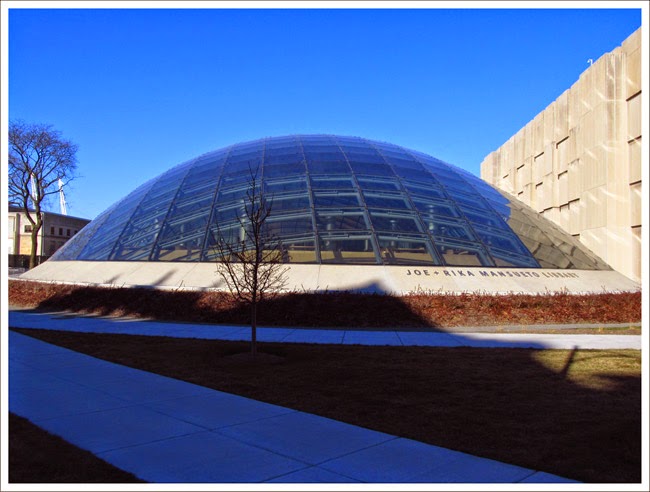South Water Market - University Commons
by: chicago designslinger
[South Water Market - University Commons (1925/2007) Fugard & Knapp/Pappageorge Haymes, architects /Image & Artwork: chicago designslinger]
There was a time not all that long ago, when "locally grown" and "locally sourced" was the norm and not the exception. Back before our food was chemically mass produced for corporate consumption, fruits and vegetables were usually sent to a central distribution point where wholesalers could sell seasonal produce grown by nearby farmers to grocers and restauranteurs located within a non-spoilage distance. Chicago, a major distribution center for all manner of products, became the center point of a produce wheel whose spokes stretched out to Cleveland, St. Louis, Milwaukee, Minneapolis, and points in between.
[South Water Market - University Commons, West 14th and West 15th Place between Morgan and Racine Streets, Chicago /Image & Artwork: chicago designslinger]
It's hard to imagine today, but the bustling produce trade was centered along the south bank of the main branch of the Chicago River from Michigan Avenue to Wells Street. The classically landscaped Wacker Drive that you stroll along today offering great views along the riverbank didn't exist 85 years ago. Warehouses lined river's edge, and a street that no longer exists South Water Market, was packed with horses, wagons, wholesalers, and their fresh fruits and vegetables. The street was messy, noisy and bursting at the seams, and served its purpose for nearly 60 years. Then in the early 1920s, the city decided to start implementing a plan that would transform the market along with Chicago's urban landscape. Proposed by Daniel Burnham and his cohort Edward Bennett in 1909, the Chicago Plan became the blueprint to finally pull the city out-of-the-mud and into a beautiful, classically inspired garden town. The dirty cacophonic produce market, so close to the central business district, didn't fit into the panoramic pristine plan.
[South Water Market - University Commons, National Register of Historic Places, Chicago /Image & Artwork: chicago designslinger]
The challenge was getting over 200 merchant/vendors to agree to move. After several attempts things finally got rolling in 1922 when the city condemned all the property as unsafe and unsanitary, and offered buy-outs. An idea was put forward to build a brand-spanking new, state-of-the-art facility as an alternative, and many of the produce wholesalers signed-on. Land for the massive project was secured as 1924 was drawing to a close, and by August 30, 1925, the last produce dealers of the old South Water Market were moving their wares over to the new South Water Market on 14th and 15th Place, between Morgan and Racine Streets, just west of Halsted.
[South Water Market - University Commons /Image & Artwork: chicago designslinger]
One-hundred and sixty-five uniform 25 foot by 80 foot storefronts, or stalls, were lined-up party wall to party wall in 6 buildings that varied in length from 450 feet, to over 800 feet. Architects Fugard & Knapp wrapped the 3-story structures in decoratively embellished, glistening glazed, terra-cotta tiles and replaced the old canvas awnings that hovered over crumbling sidewalks, with sturdy, crisp, clean iron and glass canopies that provided cover over wide loading docks. The streets were 90 feet wide, nearly double the width of the street along the river, and the entire complex was cooled by pipes running underground and linked to individual stalls by the Chicago Cold Storage Company, keeping the fruits and vegetables chilled. This was big business, generating over $800 million in trade. Yet amazingly, for all the great planning, the market wasn't linked to the adjacent rail line that ran along the southern edge of the property. So it was left to horses and wagons, and at the time small trucks, to move goods in and out of the facility. By the 1930s as truck grew ever larger in size, maneuvering the 90 feet between buildings became harder and harder, and by the 1980s, Chicago was no longer the Midwest's dominant produce trading force.
Like the old market street before it, by 1996 the "new" South Water Market was outdated and losing more and more of its market share. In 2003, 59 of the remaining 62 owners sold their stalls and a few of them moved to a new state-of the-art facility. The new/old Water Market buildings were then converted into 800+ residential loft condominiums under the supervision of architects Pappageorge Haymes. The market's replacement no longer carried the South Water name, and the new Chicago International Produce Market on South Wolcott Street is currently home to 19 produce wholesalers including the oldest in the city, Strube Celery & Vegetable founded on South Water Market - next to the river - in 1913.
Like the old market street before it, by 1996 the "new" South Water Market was outdated and losing more and more of its market share. In 2003, 59 of the remaining 62 owners sold their stalls and a few of them moved to a new state-of the-art facility. The new/old Water Market buildings were then converted into 800+ residential loft condominiums under the supervision of architects Pappageorge Haymes. The market's replacement no longer carried the South Water name, and the new Chicago International Produce Market on South Wolcott Street is currently home to 19 produce wholesalers including the oldest in the city, Strube Celery & Vegetable founded on South Water Market - next to the river - in 1913.






















